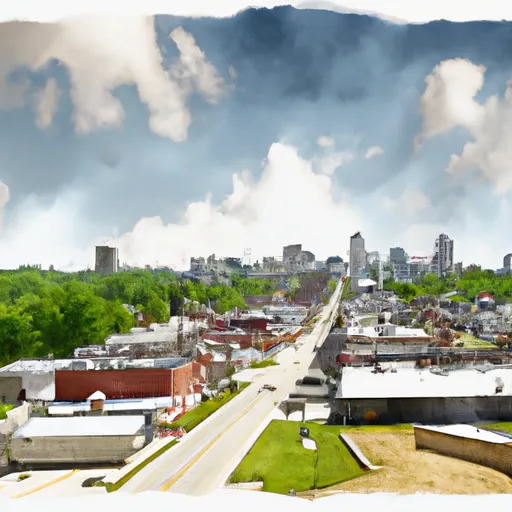-
 Snoflo Premium
Snoflo Premium
Get unlimited access to all our content
With no Ad interruptions! - Start Your Free Trial Login with existing account
Tiny-Town
Eden Index
Climate
7.9
•
Recreation
2.2
•
Community
•
Safeguard
3.9/10

Tiny-Town, Kentucky is a small, picturesque town located in the heart of the state. The town experiences a moderate climate, with hot and humid summers and mild winters. Summers see average temperatures ranging from 80 to 90 degrees Fahrenheit, while winters bring temperatures between 30 and 40 degrees Fahrenheit. Precipitation is fairly evenly distributed throughout the year, with an average of 45 inches annually.
Hydrology constituents in Tiny-Town are diverse, with numerous water bodies enriching the area. The town is blessed with several lakes and rivers, offering plenty of opportunities for fishing, swimming, and boating. The serene Blue River flows through the outskirts, providing a tranquil backdrop for outdoor enthusiasts.
Outdoor recreation options are abundant in Tiny-Town. The town is surrounded by lush green forests, making it a haven for hikers and nature lovers. Trails crisscross through the woodlands, offering a chance to explore the local flora and fauna. Additionally, the nearby lakes are perfect for camping, picnicking, and water sports.
Overall, Tiny-Town, Kentucky offers a welcoming climate, diverse hydrology constituents, and a range of outdoor recreation opportunities, making it an ideal destination for nature enthusiasts and those seeking tranquility amidst scenic beauty.
What is the Eden Index?
The Snoflo Eden Index serves as a comprehensive rating system for regions, evaluating their desirability through a holistic assessment of climate health, outdoor recreation opportunities, and natural disaster risk, acknowledging the profound impact of these factors on livability and well-being.
Climate Health Indicator (CHI): 7.9
Tiny-Town receives approximately
1305mm of rain per year,
with humidity levels near 83%
and air temperatures averaging around
15°C.
Tiny-Town has a plant hardyness factor of
7, meaning
plants and agriculture in this region tend to thrive during the non-winter months.
By considering the ideal temperature range, reliable water supplies, clean air, and stable seasonal rain or snowpacks, the Climate Health Indicator (CHI) underscores the significance of a healthy climate as the foundation for quality living.
A healthy climate is paramount for ensuring a high quality of life and livability in a region, fostering both physical well-being and environmental harmony. This can be characterized by ideal temperatures, reliable access to water supplies, clean air, and consistent seasonal rain or snowpacks.
Weather Forecast
Streamflow Conditions
Lower Cumberland
Area Rivers
Lower Cumberland
Snowpack Depths
Lower Cumberland
Reservoir Storage Capacity
Lower Cumberland
Groundwater Levels
Recreational Opportunity Index (ROI): 2.2
The Recreational Opportunity Index (ROI) recognizes the value of outdoor recreational options, such as parks, hiking trails, camping sites, and fishing spots, while acknowledging that climate plays a pivotal role in ensuring the comfort and consistency of these experiences.
Access to outdoor recreational opportunities, encompassing activities such as parks, hiking, camping, and fishing, is crucial for overall well-being, and the climate plays a pivotal role in enabling and enhancing these experiences, ensuring that individuals can engage in nature-based activities comfortably and consistently.
Camping Areas
| Campground | Campsites | Reservations | Toilets | Showers | Elevation |
|---|---|---|---|---|---|
| Six Mile Creek | None | 110 ft | |||
| Joe Wheeler State Park | 116 | 573 ft | |||
| Tannehill Ironworks Historical State Park | 300 | 435 ft | |||
| David Crockett State Park | 107 | 947 ft | |||
| Blue Creek | None | 195 ft | |||
| Res 26 - Greene - Sullivan State Forest | 25 | 498 ft | |||
| Burchfield Branch Park | 36 | 473 ft | |||
| Montgomery Bell State Park | 80 | 618 ft | |||
| Paul M Grist State Park | 11 | 337 ft | |||
| Harpeth River Bridge | None | 393 ft |
Nearby Ski Areas
Catastrophe Safeguard Index (CSI):
The Catastrophe Safeguard Index (CSI) recognizes that natural disaster risk, encompassing floods, fires, hurricanes, and tornadoes, can drastically affect safety and the overall appeal of an area.
The level of natural disaster risk in a region significantly affects safety and the overall livability, with climate change amplifying these risks by potentially increasing the frequency and intensity of events like floods, fires, hurricanes, and tornadoes, thereby posing substantial challenges to community resilience and well-being.
Community Resilience Indicator (CRI):
The Community Resilience Indicator (CRI) recognizes that education, healthcare, and socioeconomics are crucial to the well-being of a region. The CRI acknowledges the profound impact of these elements on residents' overall quality of life. By evaluating educational resources, healthcare accessibility, and economic inclusivity, the index captures the essential aspects that contribute to a thriving community, fostering resident satisfaction, equity, and social cohesion.

